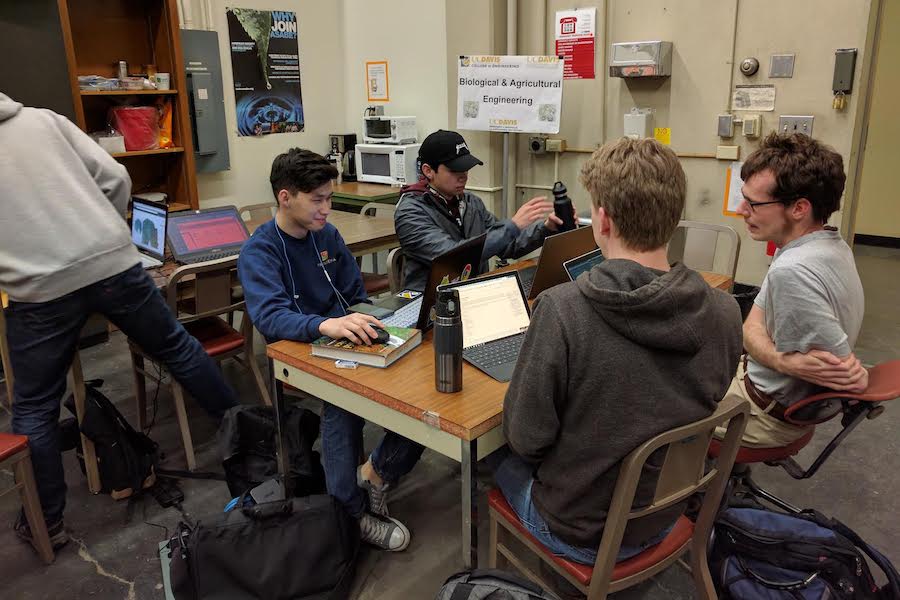
UC Davis Robotics Team prepares for upcoming Micromouse competition
Psychologists once dropped mice in small mazes and measured the time it took for the rodents to reach the ends of the mazes. In the late 1970s, engineers took on a challenge to mirror this labyrinth experiment and construct the wandering mice as small, autonomous robots. Today, this challenge is known as Micromouse, a competitive event in which engineers design and program robotic mice to independently solve a 16 cm x 16 cm grid cell maze.
Micromouse competitions are held worldwide and welcome a variety of robot-enthusiasts that range from beginner programmers to expert engineers. New to the competition is the UC Davis Robotics Team, a diverse group of engineering students eager to apply their skills and learn more about competitive robotics. The team is currently preparing for the Institute of Electrical and Electronics Engineers’ (IEEE) Micromouse competition this May, which will be held at UC San Diego.
“The Micromouse competition consists of an autonomous (i.e. pre-programmed) robot that is tasked with solving a maze,” said Braden Rhoads, a second-year electrical engineering major and the Robotics Team captain in an email interview. “The robot must find its way through a maze that is completely new to it, spending the first round solving the maze, and spending the second round going through it as fast as possible by mapping out the fastest route from beginning to end.”
To ensure that the UC Davis mouse has optimal support and successfully reaches the end of the maze, the team has split itself into three sub-teams: computer programming, electrical design and mechanical design.
Naveed Oroumchian, a second-year electrical engineering major, works with the electrical design sub-team to construct a solid foundation for the operating mouse.
“For our part of it, we’re responsible for finding a microcontroller and sensors, and making [the mouse] into one system,” Oroumchian said. “Then we tell the mechanical design team to construct [the exterior], and the computer programming team creates a program to work with it.”
Ben Hough, a third-year computer science and engineering major, described his duties as a computer programming sub-team member.
“As the programming team, our job is to connect the high-level mini-solving algorithms with the low-level motor control so that the mouse can successfully navigate the maze,” Hough said. “To do that, the mouse has several sensors that can help it gain information as to where it is. The mouse has encoders on its motors which measure how many times its wheels rotate, and from that we can get the distance. It also has infrared sensors, which can measure distance from walls.”
The mechanical design sub-team is working on reducing the weight of the mouse, which will ease rapid turning motions, according to Hough.
The IEEE competition will be the first Micromouse event for some Robotic Team members, including Oroumchian. He has so far enjoyed contributing to the team and looks forward to furthering his knowledge of electrical engineering through competitive robotics.
“As a second year, I’m still learning about all of the electrical systems,” Oroumchian said. “Hopefully this will help me gain some experience in the field and I can play a bigger part [on the team] in the future.”
For Hough, the IEEE competition provides an opportunity to improve his programming skills and collaborate with fellow engineers. He entered the competition with his junior college team in the past, but his previous team’s mouse encountered technical difficulties during its maze run.
“We never got it to complete an entire maze, so I’m really hoping that we can get to that stage,” Hough said. “There’s a lot that goes into finishing one maze, so if we could do that, I’d be really excited.”
As the UC Davis Team begins assembling its first robotic mouse, Rhoads has high hopes for the IEEE competition.
“Coordination is key, and thus along with each of [our] sub-teams working on their particular portion of the robot, we are preparing by making sure everything comes together perfectly,” Rhoads said. “Overall, I am very proud of my team and the work we have been contributing, and I believe we will be strong contenders in the upcoming competition.”
Written by: Emma Sadlowski — science@theaggie.org



